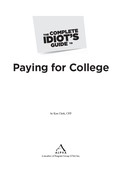Employer Tuition Programs
I have to admit that I didn’t think very many employer tuition programs existed until a few years ago when I started teaching at the University of Phoenix. But I consistently run into employee after employee who is getting money from his company to pursue his Bachelor’s or Master’s degree. Even better, these students weren’t just getting a few hundred bucks; most of them were getting their tuitions reimbursed up to the IRS limit for tax-free tuition reimbursement—or $5,250 in 2010. Considering that many of my students were making only $25,000 per year at their jobs, using their employers’ tuition reimbursement programs was equivalent to a 20 percent tax-free raise!
Most often, tuition reimbursement comes in one of two forms:
• Direct bill—Under this arrangement, the college an employee attends simply submits a bill to the employer, who then pays it. However, employees might still be responsible for paying registration and other fees, as well as for their books.
• Voucher—Although not as common, some employers provide their employees with a voucher or coupon that they can use at any accredited school. The school in turn submits this voucher to the employer for reimbursement.
The Fine Print of Employer Reimbursement
There are literally thousands of employers that reimburse tuition, but these programs are not without some fine print. It’s important to understand how these programs work before you take a few classes and then find yourself stuck with a hefty bill.
Here are some of the key components you need to consider before you begin:
• Length of service—Many employer tuition reimbursement plans do not kick in until an employee has been there for at least 6 or 12 months. The exception is usually free tuition for employees of an actual college, which often begins immediately or within 30 days.
• Upfront payment—Some plans require an employee to pay the tuition upfront, only being reimbursed after she successfully completes a class. Many nontraditional schools do offer more flexible payments terms for students using employer reimbursement to help minimize their out-of-pocket expenses.
• Minimum grades—Most tuition reimbursement programs will not reimburse students for Ds or Fs. In fact, some programs reimburse employees 100 percent only if they receive an A, with Bs and Cs being reimbursed at a lower percentage.
• The IRS limit—The IRS places a limit on the amount of tuition reimbursement an employee can receive before taxes kick in. For 2010, an employee can receive $5,250 in tuition reimbursement tax-free. Anything above this amount is taxable, with money owed to the IRS usually being withheld from the employee’s paycheck.
Finding a Job with Tuition Reimbursement
Before you decide to move across the country to try to land a job at a company that offers tuition reimbursement, you’ll need to check what’s available in your own back-yard. As a general rule, the larger and more profitable a company is, the more likely it is to offer tuition reimbursement for its employees.

CHEAT SHEET
You might not have to switch jobs to get tuition reimbursement. Consider asking your boss to institute a tuition-reimbursement plan as an employee benefit or to give you part of your next raise in the form of tuition reimbursement. In doing so, both you and the employer avoid paying payroll taxes on that money (roughly 8 percent each), as well as you having to pay income taxes on it under the annual IRS limit.
So start by doing an Internet search for the largest employers in your county and state. When you find local companies that look like they could be a good fit for you, simply pick up the phone and call that company. Ask to speak to someone in their human resources department and then tell them that you’re considering applying for a job with them and were wondering if they offer tuition reimbursement to their employees. If they say “yes,” see whether you can get any additional details, such as how long you have to wait before you’re eligible and how much it covers.
If no major companies are headquartered or have operations in your area, grab a copy of Forbes magazine’s annual list of the 100 Best Companies to Work For. Not only do the majority of these companies offer some level of tuition reimbursement, but their other benefits also make picking up your life and moving elsewhere all that much more worthwhile. The annual list of Fortune 500 companies (America’s biggest corporations) is also a great place to begin doing research and making phone calls because these companies have deep enough pockets to offer employee tuition reimbursement.
Lastly, even though it is a bit of a long shot, you can try calling your local college and asking to speak to someone in the student billing department. Because these individuals are the ones involved in the billing and reimbursement process with local businesses, a sympathetic soul might be willing to rattle off a few company names if you tell him you’re trying to find a future employer who takes care of its employees.
Tuition for Employees’ Children
Many of employer tuition reimbursement programs have been expanded in recent years to include putting one’s spouse or children through college. Although this is still relatively rare, students with children of their own should consider jobs at these companies to be worth their weight in gold. The easiest places to find jobs that offer tuition to spouses and children are the colleges themselves, so check to see whether any schools in your area are hiring.
It is important to note that some of these companies that do offer benefits for family members allow only one family member to use the tuition benefit at a time. So if you’re the parent of twins or triplets, you might be out of luck.
..................Content has been hidden....................
You can't read the all page of ebook, please click here login for view all page.
